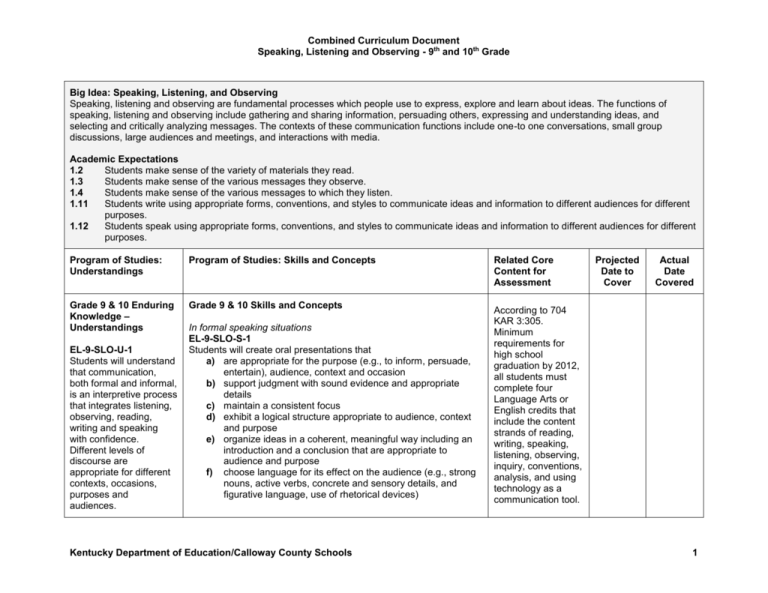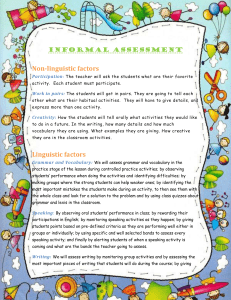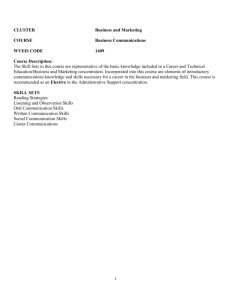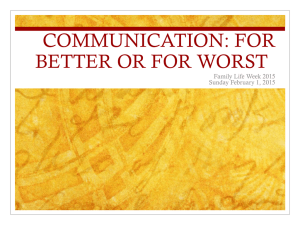Combined Curriculum Document Speaking, Listening and Observing
advertisement

Combined Curriculum Document Speaking, Listening and Observing - 9th and 10th Grade Big Idea: Speaking, Listening, and Observing Speaking, listening and observing are fundamental processes which people use to express, explore and learn about ideas. The functions of speaking, listening and observing include gathering and sharing information, persuading others, expressing and understanding ideas, and selecting and critically analyzing messages. The contexts of these communication functions include one-to one conversations, small group discussions, large audiences and meetings, and interactions with media. Academic Expectations 1.2 Students make sense of the variety of materials they read. 1.3 Students make sense of the various messages they observe. 1.4 Students make sense of the various messages to which they listen. 1.11 Students write using appropriate forms, conventions, and styles to communicate ideas and information to different audiences for different purposes. 1.12 Students speak using appropriate forms, conventions, and styles to communicate ideas and information to different audiences for different purposes. Program of Studies: Understandings Program of Studies: Skills and Concepts Grade 9 & 10 Enduring Knowledge – Understandings Grade 9 & 10 Skills and Concepts EL-9-SLO-U-1 Students will understand that communication, both formal and informal, is an interpretive process that integrates listening, observing, reading, writing and speaking with confidence. Different levels of discourse are appropriate for different contexts, occasions, purposes and audiences. In formal speaking situations EL-9-SLO-S-1 Students will create oral presentations that a) are appropriate for the purpose (e.g., to inform, persuade, entertain), audience, context and occasion b) support judgment with sound evidence and appropriate details c) maintain a consistent focus d) exhibit a logical structure appropriate to audience, context and purpose e) organize ideas in a coherent, meaningful way including an introduction and a conclusion that are appropriate to audience and purpose f) choose language for its effect on the audience (e.g., strong nouns, active verbs, concrete and sensory details, and figurative language, use of rhetorical devices) Kentucky Department of Education/Calloway County Schools Related Core Content for Assessment Projected Date to Cover Actual Date Covered According to 704 KAR 3:305. Minimum requirements for high school graduation by 2012, all students must complete four Language Arts or English credits that include the content strands of reading, writing, speaking, listening, observing, inquiry, conventions, analysis, and using technology as a communication tool. 1 Combined Curriculum Document Speaking, Listening and Observing - 9th and 10th Grade EL-9-SLO-U-2 Students will understand that regardless of the topic, the context or the intended audience, students need to be able to communicate ideas effectively. Effective communication involves verbal and nonverbal techniques to enhance or emphasize content. These techniques aid the listener’s ability to interpret the information. EL-9-SLO-U-3 Students will understand that language usage is related to successful communication; language patterns and vocabulary transmit culture and affect meaning. EL-9-SLO-S-2 Students will apply delivery techniques a) both verbal (e.g., tone, volume, rate, articulation, inflection, pacing) and nonverbal (e.g., gestures, facial expressions, eye contact) b) avoid distracting delivery behaviors (e.g. excessive verbal pauses, fidgeting) c) use language appropriate to audience; use specialized content vocabulary as needed d) adhere to standard guidelines for grammar, usage, mechanics or use non-standard language for effect when appropriate (e.g., word plays, common figures of speech) e) choose language for its affect on the audience (e.g. strong nouns, active verbs, concrete and sensory details, figurative language) Skills used for speaking, listening and observing are not tested at the state level (KCCT). Check local district/school curriculum for assessment policy. EL-9-SLO-S-3 Students will use visual aids, media and tools of technology to support oral communication EL-9-SLO-S-4 Students will document ideas from outside sources (e.g., citing authors, titles, websites) In informal speaking situations EL-9-SLO-S-5 Students will give spoken instructions to perform specific tasks EL-9-SLO-S-6 Students will ask and respond to questions as a way to enrich class discussions EL-9-SLO-S-7 Students will play a variety of roles in group discussions (e.g., discussion leader, facilitator, responder) When listening EL-9-SLO-S-8 Students will give and follow spoken instructions to perform specific Kentucky Department of Education/Calloway County Schools 2 Combined Curriculum Document Speaking, Listening and Observing - 9th and 10th Grade tasks EL-9-SLO-S-9 Students will identify the controlling idea of a speech and key ideas that support it EL-9-SLO-S-10 Students will respond critically (analyze the style of a speech, including the speaker’s choice of language to evoke a response, evaluate conclusions, credibility of information presented) EL-9-SLO-S-11 Students will respond to information in a variety of ways by summarizing, taking useful notes, organizing, analyzing or recording that which is meaningful and useful EL-9-SLO-S12 Students will respond appropriately/respectfully (e.g., ask questions, respond with civility/respect) EL-9-SLO-S-13 Students will follow the organization of a presentation and recognize the speaker’s use of transitions EL-9-SLO-S-14 Students will interpret and evaluate the effectiveness of verbal and nonverbal delivery techniques, including visual cues EL-9-SLO-S-15 Students will build on the ideas of others and contribute appropriate information or ideas EL-9-SLO-S-16 Students will use self-evaluations and feedback from teachers and peers to improve presentations Kentucky Department of Education/Calloway County Schools 3 Combined Curriculum Document Speaking, Listening and Observing - 9th and 10th Grade EL-8-SLO-U-4 Students will understand that observation involves interpreting and constructing meaning. By viewing in context, students infer, construct meaning, draw conclusions and form opinions about the world around them. When observing EL-9-SLO-S-17 Students will use a variety of criteria (e.g., clarity, accuracy, effectiveness, bias, relevance of facts) to evaluate media EL-9-SLO-S-18 Students will evaluate the role of media in focusing attention and in forming opinion EL-9-SLO-S-19 Students will interpret a variety of techniques used in advertising EL-9-SLO-S-20 Students will analyze the effectiveness of visual and auditory cues (e.g., cutaway, close-up or long shot, voiceover, sound effects) to enhance the message or understand context Kentucky Department of Education/Calloway County Schools 4





